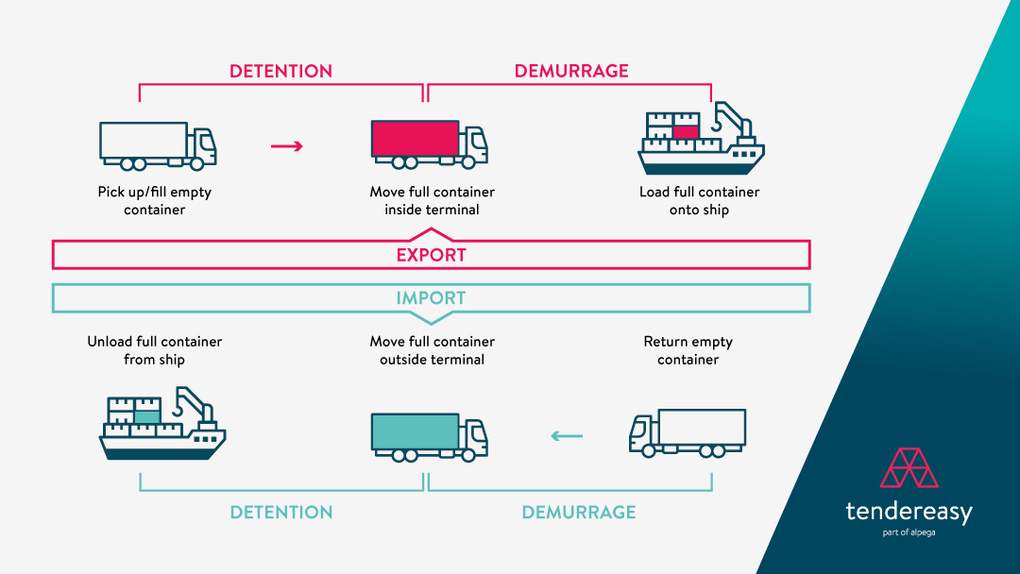In our last installment of the Ocean Freight Basics blog series, we discussed the topic of ocean freight forecasting and how it influences freight rates. If you’re looking for another effective way to save money on ocean freight, the topic of demurrage and detention fees is just as important.
In this blog post we’ll define these fees, explain how they work and provide expert advice on how to avoid them.
What are detention and demurrage fees, who charges them and why?
If you ship goods by sea, you may have already noticed unexpected additional costs from demurrage and detention fees.
These fees are levied as an incentive for shippers to return containers in a timely manner. The owners of facilities and equipment (port warehouses, freight stations, container yards and containers) charge the fees as a way of ensuring necessary storage space is available and reducing turnaround time. These owners are usually terminals or shipping lines (carriers). The burden of the fees falls to shippers.
The amount charged varies by carrier and port, but one common feature is that the charges are applied for every day a shipper remains in violation of the time limit (“free days”) agreed upon.
If a shipper isn’t careful, these daily charges can add up – in some cases accruing up to 20 times the value of the container itself. We’ll present strategies for how best to avoid these costly charges, but first it’s necessary to get more specific about each of the terms.
Demurrage fees
Demurrage fees are applied for use of containers inside the port terminal.
Both export and import phases can accrue demurrage fees: for export, the fees start when the container enters the terminal and end upon loading onto a ship; for import, they start when a container is discharged from a ship and end when a container is picked up at the terminal.
To calculate the period of demurrage, carriers must provide a reasonable free-time period, during which a shipper is free to load or unload their goods. After the free time, agreed upon between shipper and carrier (or container owner), the fees begin.
Detention fees
Detention fees refer to container activities outside the port terminal.
And, like demurrage, detention applies to both export and import flows: for export, detention fees start when the empty container leaves the terminal and end when the full container returns; for import, the fees start when a full container is picked up from the terminal and end when the empty container is returned.
Carriers must provide a reasonable free time period.
“Free-time period” or “free days” – the key to calculating demurrage and detention fees
Carriers cannot reasonably expect shippers to load or unload containers instantaneously. It is therefore the responsibility of shippers and carriers to agree upon the number of free days provided for the shipper to load/unload their goods before demurrage or detention fees begin.
Free days can vary based on ports and shipping lines, but it remains a key concept for shippers, as free days can be negotiated.
Expert tips for avoiding demurrage and detention fees
Since they’re based on factors like port congestion and late goods, demurrage and detention fees can’t always be avoided. The good news is, these fees are negotiable with carriers. A better communication flow between shippers and carriers ensures that if demurrage/detention fees are applied, they’re as fair as possible.
Build clear agreements on demurrage and detention fees into RFQs
The simplest way to manage demurrage and detention fees, as a shipper, is to reach clear agreements with carriers in the RFQ process.
Large volume shippers, for instance, can select carriers that will provide more free days based on shipping volume. Even if you don’t fall into this category, you can still can select for carriers that offer competitively low fee structures for demurrage and detention, as long as this information is included in your RFQ.
Being strategic in the RFQ process can help shippers actively avoid demurrage and detention fees. However, this can be a difficult process to manage manually. A purpose-built tool like TenderEasy can help you streamline your RFQ building process and apply the parameters you need to find carriers who give you better deals on fees (and better deals on freight rates, too).
Manage documentation digitally for quicker customs clearance
One of the best strategies for avoiding demurrage and detention fees is to pre-clear cargo through customs. This, however, is easier said than done if your goods documentation is still managed by manual processes. TenderEasy provides freight procurement solutions that help you keep documentation managed digitally, ensuring you get faster clearance at the port – and avoid fees.
Take full advantage of the free days
To avoid detention charges, shippers can take steps to ensure a successful shipment by preparing cargo for pickup on time and, if possible, dispatching cargo in advance. This gives trucking companies an ample scheduling window, and enables shippers to fill a given container more rapidly, effectively minimizing the time the container is outside of the port.
To avoid demurrage charges, shippers can share the delivery instructions of a shipment in advance; this is a very effective way to set yourself up for smooth activities at the port terminal. But again, this process is easier when you have a single digital platform to manage these flows. TenderEasy provides just that service, with an easy-to-use interface shippers appreciate.
For more information on how TenderEasy’s solutions can help your business avoid demurrage and detention fees, please get in touch.
